Fleet refresh: high ambition but beware of the traps
In an exclusive interview, Defence Minister Richard Marles says he is designing a far more capable and lethal navy.
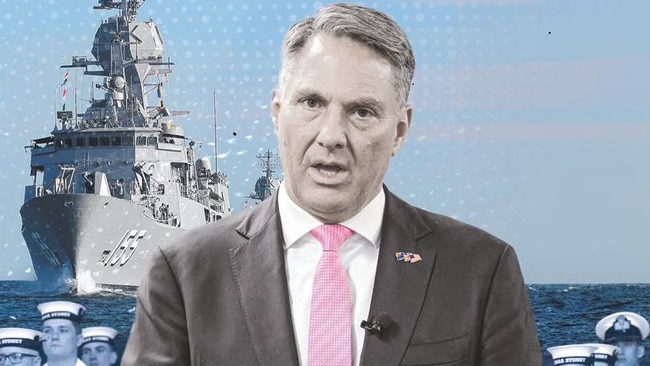
The upshot is that Richard Marles needs to become a long-run defence minister able to entrench his sweeping redesign of the Australian navy.
He has a triple task: terminating the procurement rupture that has plagued the defence system, reviving the nearly forgotten Labor tradition of defence policy commitment, and asserting long-lost ministerial ownership and control of the nation’s defence strategy.
The past pattern is ominous – that suggests Marles will fail. For the past year he has been surrounded by a fog of conjecture that the task is too great and Labor’s commitment is too weak.
Albanese Labor needs to break that pattern for Australia’s sake and for Labor’s governing credentials. The two areas where failure could bring Anthony Albanese undone are the economy and national security.
There is no quick transformation in naval capability. Past Labor and Coalition prime ministers created an untenable revolving door in the defence portfolio. The Coalition effort was dismal. It oversaw six defence ministers in nine years.
Since 2007 under Labor and Coalition there have been 10 ministers in 15 years. Not all defence ministers were inept but the collective result was grossly inadequate. That is not a record that suggests national security was a political priority.
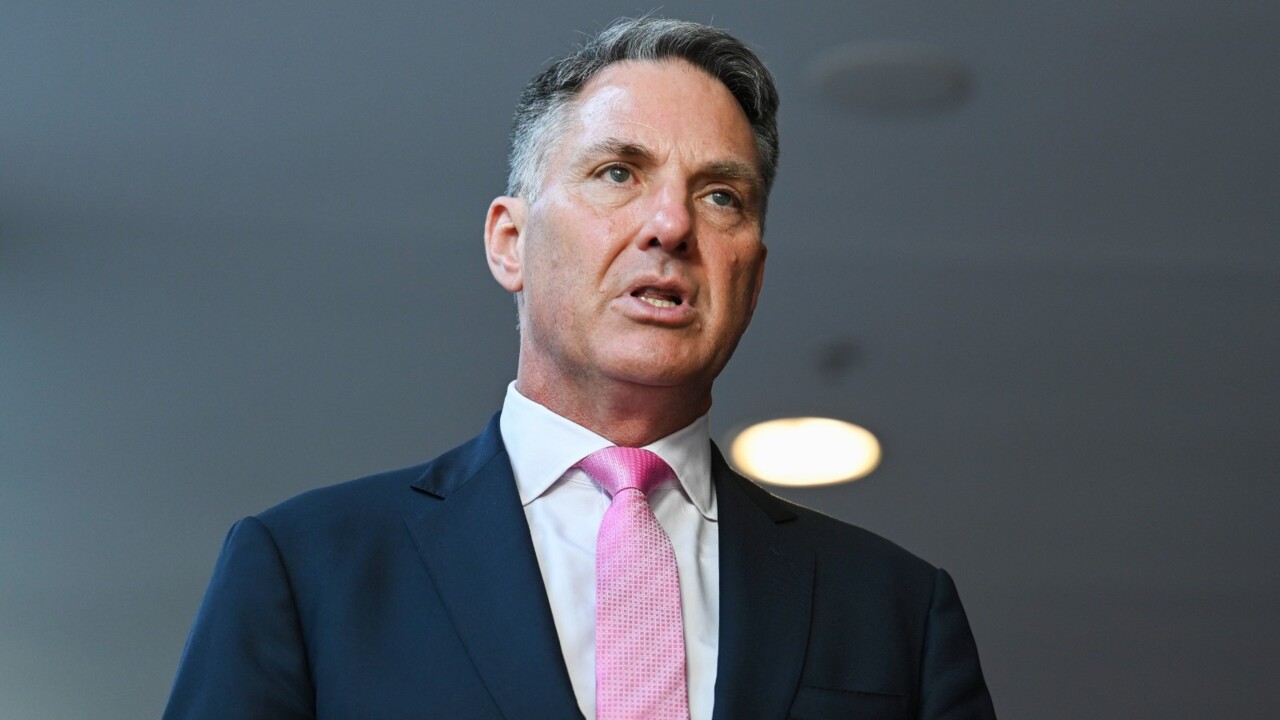
Marles has now put in place a plan for the navy’s transformation stacked with ambition – this week’s surface fleet decisions mean the current 11 warships will be expanded over time to 26 ships; a system of continuous naval shipbuilding will be established in Adelaide and Perth with electoral dividends for Labor; the defence budget will be increased to 2.4 per cent of GDP by the early 2030s; and the AUKUS agreement is being advanced with its plan for Australia to acquire nuclear-powered submarines, by buying three Virginia-class boats from the US and building a joint British-Australian nuclear-propulsion sub.
It is an astonishing agenda in strategic, defence industry and organisational terms – and it is riddled with traps.

Opposition defence spokesman Andrew Hastie says the Coalition welcomes “the ambition of this plan”. But Hastie raises a score of concerns. He accuses Marles of failing to get sufficient funds and not fixing anything in the immediate short term.
Marles needs to become Labor’s most important defence minister since Kim Beazley. Nothing else will suffice. The task he confronts is herculean. The 2023 Defence Strategic Review said Australia faced its most dangerous strategic situation since World War II and slammed our defence capability acquisition – alluding to the Defence Department – as not fit for purpose.
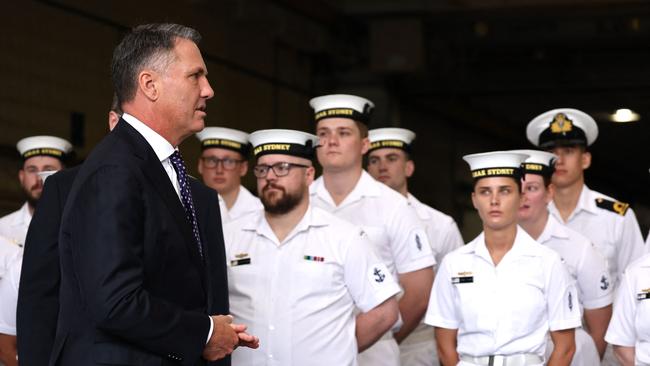
The burning question becomes: how much of this ambition is tenable?
Given its resistance to change, how can the Defence Department deliver such programs on budget and on time? How can the budget and economy finance the scale of ambition? Given the immediacy of China’s challenge, how can Australia cope with the delay in delivering our expanded naval power? Does the Albanese government really accept the DSR demand that national security become a “whole-of-nation” concept?
And, finally, is Marles up to the job?
Marles says: “There needs to be a long-term defence minister in this country. Part of the cultural problem Defence faces is not of the department’s making. It is demoralising to see six or seven defence ministers cycle through over nine years. Part of the problem is how this portfolio has been treated within governments. I know there needs to be a long-term defence minister and I aspire to be that. Time will tell how it plays out. But churn has been a key part of the problem.”
The navy review enshrined two fresh initiatives: a fleet of 11 general-purposes frigates to replace the Anzac-class, the first three being purchased “off the shelf” to speed acquisition, with the timetable for the first frigate to be in service late in the decade of the 2020s; and a future-focused decision to acquire six autonomous vessels, in the experimental phase in the US, often branded “drone ships” that can function uncrewed but would be crewed under the navy’s plans.
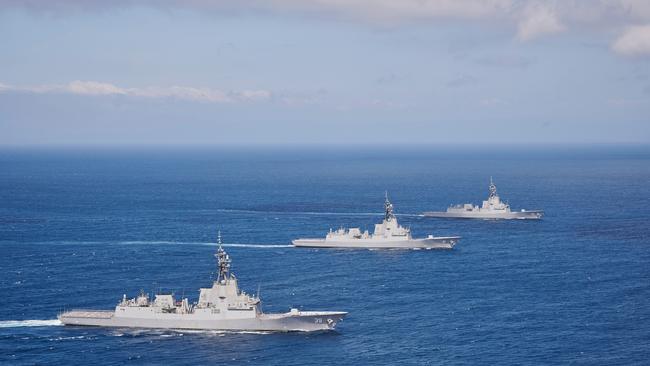
The problem is that because of the current ageing fleet, the navy’s size will contract before it expands. Only in the early 2030s will its strength exceed current numbers. This is a structural problem reflecting past failures. “We need to get capability as soon as we can,” Marles says.
“The plan we inherited would have seen the first new warship come into service, the Hunter-class frigates, in 2034. The timeframe hasn’t changed for that ship. But we have accelerated acquisition of three general-purpose frigates and on the timeframe we inherited – one new warship by 2034 – we will have four ships.”
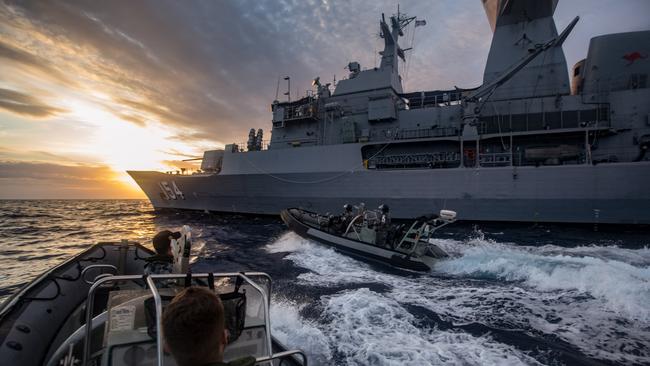
At this point Marles and Labor assume full political ownership of defence policy with the inherent dilemma it brings – the more ambition you seek, the more things can go wrong.
In defence acquisition things always go wrong; it’s a question of how badly they go wrong. Labor will become the party of bold naval acquisition or sink into a sprawling mess, with the Defence Department unable to cope and timetables hopelessly delayed.
Issuing a sceptical warning, analyst and former Labor adviser Hugh White tells Inquirer: “Labor is trying to re-establish its credentials as the party of defence policy but it’s doing this without sufficiently thinking through the strategic circumstances.”
Marles rejects this. He says the DSR has given Labor a new defence policy road map that it intends to implement.
He delivers three messages: by the 2030s Australia will have an enhanced and far more lethal naval capability; the extra funds are locked in for a full decade; and he says he will exercise a stronger hands-on authority over the Defence Department – frankly, an essential condition for success. The method of ministers functioning at arms’ length from the department doesn’t work.
In strategic terms Australia is not designing a navy to fight a war against China in the Taiwan Strait. We are designing a navy for our national interest.
Marles says: “Our aim is a far more capable and lethal navy that can act on its own and realistically give our country an ability to deter coercion from any adversary. When we took office we inherited a declining navy, the oldest surface fleet since the end of the second world war.
“What we are doing is preparing to operate in an uncertain world over coming decades. This is not about preparing for a specific scenario. We are watching a major power contest, highly relevant to us, where the outcome is not certain. We need to build a navy much more capable, able to act independently and deter any attempt to coerce.
“The plan outlined this week in conjunction with our planned nuclear submarines will mean Australia’s military capability in a decade will be of a level we have never had before as a country. And we will need this capability.”
In any US-China conflict over Taiwan, Australia would have vital decisions to make. But any role Australia brought to bear would be strictly marginal. Any sense that fighting China in the Taiwan Strait is the guiding principle of the fleet review is misconceived.
The further reality, as the DSR says, is that the US is no longer the “unipolar leader of the Indo-Pacific”, with US-China rivalry now “the defining feature of our region”.
There is one certainty – China’s regional influence will only grow. The need for capable surface ships and nuclear-powered submarines will be greater even in the 2030s and ’40s than it is now. This obvious point seems to be continually overlooked. The long-run matters and the long-run needs to be addressed now.
Marles is sensitive to media criticism over the past year that he failed to persuade Anthony Albanese, Jim Chalmers and Foreign Minister Penny Wong on the defence budget. The DSR was released last year declaring there could be no business as usual but offered no extra money across the forward estimates. It compromised Labor’s defence project.
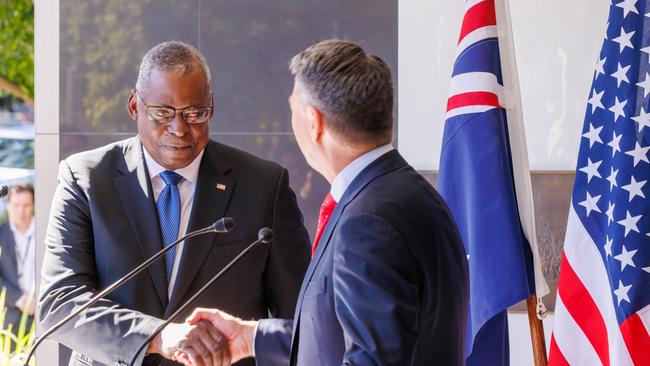
United States Studies Centre defence analyst Peter Dean, a principal author of the DSR, tells Inquirer of the government: “They basically shot themselves in the foot politically. I think the defence review was relatively well received and it is quite a radical transformation. But having no new money in the forward estimates, despite the strategic threat that had bipartisan consent, was an untenable position.”
That’s now corrected in part. Will the new money announced this week be enough? Marles says:
“Over the next decade the cost of procuring the fleet will be $54bn. We are increasing the defence spending over the decade by an additional $11.1bn and that includes $1.7bn over the forward estimates. This plan is fully funded for a decade. It is not make-believe.
“This is real money and it will be in the budget papers in May. It means our defence spending in the early 2030s will be 2.4 per cent of GDP while the trajectory under the previous government was 2.1 per cent.”


Marles makes the point – it’s guaranteed and locked in. But neither the opposition nor the critics will buy its adequacy. They distrust Labor’s convictions. The history of price escalation in defence suggests the costs will far exceed the current budget. But the Coalition needs to be careful: its record hardly stands up, its technique in office being the announcement of programs without the funding.
Marles says he will be exercising greater oversight and authority on the department’s performance. “I seek to be hands-on,” he says.
“I think that’s a critical part of how we execute the programs.” This follows his recent public remarks that Defence has a “long way go” before it achieves “a culture of excellence”. Asked if he believes Defence can rise to the challenge, Marles says: “I am confident. But the department needs to improve its performance. The senior leadership knows that. I don’t make any apology for challenging Defence to be excellent.”
There is a widespread view that Marles has been too soft in managing the department. Dean says: “The Defence Department is notorious for resisting reform.”
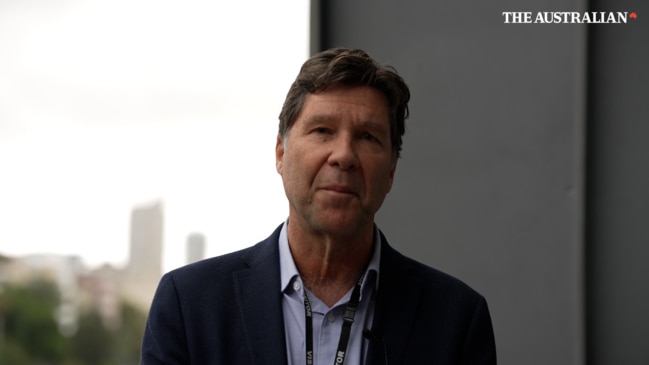
Analyst and former Defence official Peter Jennings has said Marles and Defence Industry Minister Pat Conroy “will now understand that, at its worst, Defence puts its own corporate interests and convenience first”.
Marles snaps back at any suggestion AUKUS and the nuclear-powered submarine project is in trouble. “It’s a gigantic challenge at many levels,” he says. “We are talking about a significant refashioning of the alliance with the US. The legislation that went through congress at the end of last year is unprecedented. I remain very confident.
“The opportunities in terms of industry are massive – developing a production line in Adelaide for nuclear-powered submarines is the most significant industrial endeavour our country has ever engaged in, full stop. Every step in the timeline we will meet. This is being driven at a ministerial level. It is bipartisan in each country, the UK, the US and Australia. Each country sees this as being in its strategic interest.”
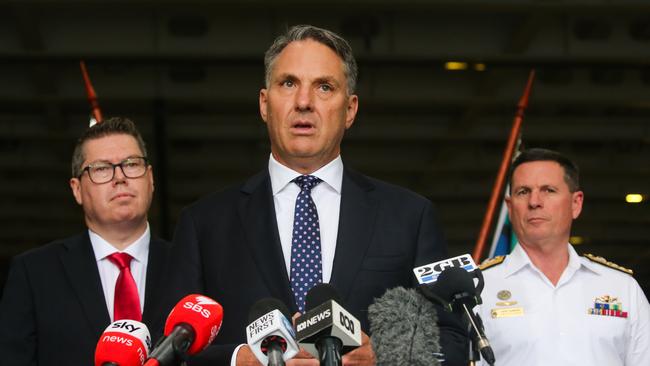
The most contentious decision in the surface fleet announcement was retention of the Hunter-class frigate program but with the ships cut from nine to six.
White says: “This a deeply flawed program. When it was announced in 2015, the idea was to start building in 2020. It’s now 2024 and they’re still a couple of years away on the most optimistic view. The Hunters are too big, too undergunned and too expensive. This looks like a perfect example of a program that should have been scrapped.”
Dean says: “The $20bn blowout in the Hunter-class budget should have spelt the end of a program littered with entrant decision-making based on wishful thinking rather than detailed analysis. My assessment is the government has come to its decision begrudgingly.”
There would have been a host of complexities: there was $4bn already spent, the need to retain the continuous shipbuilding program would have been pressing, concern about cancelling another contract after the French subs cancellation might have weighed and the critical issue was surely: was there a viable alternative ship that could be produced in the same timeframe? Dean says: “The big question was: if you cancelled Hunter what did you replace it with?”
The decision to buy overseas the first three of the new general-purpose frigates is widely applauded. It’s down to four potential designs from Spain, Germany, South Korea and Japan. This opens up the potential for new defence partners. But the timetable works only if the Defence Department cuts through on this decision-making process. This is an immediate test for Marles – driving this timetable.
In his critique, Hastie says: “Richard Marles today should be asking himself: what can I fix by 2026?” Neat question but there’s no silver bullet answer. In the short term the navy fleet will be smaller.
“This is a structural problem that both sides of politics own,” Dean says. “It comes from either failing to make decisions or not making the right decisions over the past 15 years. This can be traced all the way back to the Rudd-Gillard era. There was a failure to make earlier enough decision to recapitalise the fleet, there were the problems with the Hunter-class and a litany of issues that includes the shipbuilding problems. Now we are structurally stuck.”
How should the capability gap be managed? White says we should spend more on aircraft, on missiles including land strike missiles, on long-range drones and sea mines – the aim being to enhance strike power quickly.
Dean says the entire force – navy, air and army – should be used to plug the gap including getting missiles onto existing platforms, enhancing strike options in air defence and building long-range missile capability.
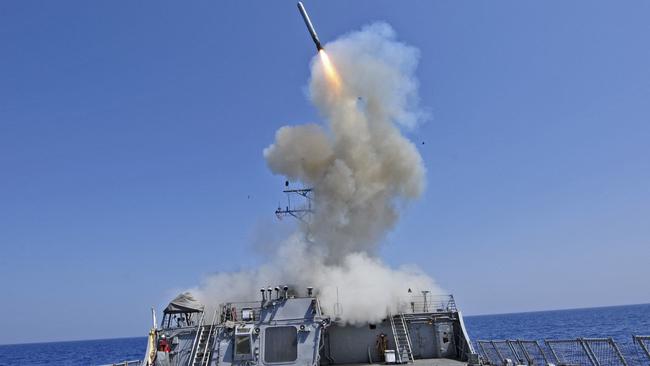
Quizzed about defence budget financing, Marles says a historical problem has been the lack of internal financial review of the Defence Department. That is now over. “We need to embrace Treasury and Finance,” he says.
“We need to embrace the idea that it’s not just how much money you spend but the quality of spend. Defence is now being opened up to Finance and Treasury and there is an expectation on everyone in the department to be working with officials from Treasury about the quality of the spend. This goes to the capability we can bring to bear. This is a key change.”
Marles says winning the support of the Prime Minister and Treasurer to lifting the defence budget is tied to the opening-up of defence and making it more accountable for the quality of the spend. Labor sees an enhanced navy as fundamental in Australia’s participation in a regional strategy of deterrence in relation to China. It sees protection of the nation’s sea lanes as pivotal.
He says: “We’re an island trading nation and we have a much greater proportion of our national income derived from trade now than in 1990 – for example, the vast bulk of our liquid fuels today come from overseas, and that one example immediately makes clear this is not about us being invaded, it is that our sea lanes with the world are fundamental to our way of life and national prosperity, and we need an ability to deter coercion.
“That requires a highly capable submarine capacity and it absolutely requires a far more capable and more lethal surface fleet with an ability to project power. That what we are seeking to build.”






Australia has not seen a successful long-term defence minister for more than a decade, a political failure at a time of unique strategic challenge.